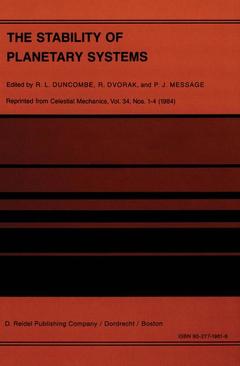Description
The Stability of Planetary Systems, 1984
Proceedings of the Alexander von Humboldt Colloquium on Celestial Mechanics, held at Ramsau, Styria, March 25-31, 1984
Coordinators: Duncombe R.L., Dvorak Rudolf, Message P.J.
Language: English
Keywords
Celestial mechanics; Kosmos; Libration; Perihel; asteroid; astrophysics; dynamics; mechanics; moon; planet; solar system; stability; universe
Publication date: 10-2011
476 p. · 15.5x23.5 cm · Paperback
476 p. · 15.5x23.5 cm · Paperback
Description
/li>Contents
/li>
The Alexander von Humboldt Colloquium on Celestial Mechanics (sub titled "The Stability of Planetary Systems") was held in Ramsau, Styria, in the Austrian Alps, from March the 25th to the 31st, 1984. The dedication of the meeting to Alexander von Humboldt presented partici pants with the challenge that the discussions during the week should reflect the spirit of that great scientist of the last century, that the very many interesting ideas presented and developed during the sessions should be interpreted in the light of a broad v~ew of astron omy and astrophysics. The topics of the meeting ranged from astrometric questions relating to the specification of inertial reference systems, motion of planets (including minor planets) and satellites, with the recurring topic of the search for criteria of stability of the systems, resonances, periodic orbits, and to the origin of the systems. Each session began with one or more invited review papers, followed by offered contributions and discussion. Three evening discussions were held, devoted respectively to inertial systems, to numerical integration techniques, and to cosmogonic problems and ring systems. On the evening of Wednesday, March 28th, a recital of chamber mus~c was given by Bernhard Piberauer, on the violin, and Meinhard Prinz, on the piano.
Preface.- Preface.- Introductory Address.- The Meaning of Celestial Mechanics in the Kosmos of Alexander von Humboldt.- Astrometric Problems.- Inertial Systems — Definitions and Realizations.- Minor Planet Observations and the Fundamental Reference System.- The Empirical Inertial System Determined in FK5 by the Dynamics of the Planetary System (Abstract).- Observations of Minor Planets with the Very Large Array.- Qualitative Methods.- Review of Concepts of Stability.- Three-Body Problem.- The Lyapunov Characteristic Exponents — Applications to Celestial Mechanics.- Kolmogorov Entropy as a Measure of Disorder in Some Non-Integrable Hamiltonian Systems.- Generalizations of the Jacobian Integral.- Application of Lie-Series to Regularized Problems in Celestial Mechanics.- Integration of the Elliptic Restricted Three-Body Problem with Lie Series.- Planetary Motions.- The Stability of Our Solar System.- Approximation Methods in Celestial Mechanics. Applications to Pluto’s Motion.- Termes Seculaires Dans la Theorie des Perturbations.- Amelioration des Theories Planetaires Analytiques.- Motions of the Perihelions of Neptune and Pluto.- Progress in General Planetary Theory (Abstract).- Satellite Motions.- Satellite Orbits and Ephemerides.- Tidal Effects and the Motion of a Satellite (Abstract).- The Effect, of the Dynamical Parameters in the Motion of the Galilean Satellites of Jupiter.- Libration of Laplace’s Argument in the Galilean Satellites Theory.- Planetary Perturbations on the Libration of the Moon.- Stability of L4 and L5 Against Radiation Pressure.- Cosmogony.- The Formation of the Planetary System.- Dynamics of Ring-Satellite Systems Around Saturn and Uranus.- Formation of the Kirkwood Gaps in the Asteroid Belt.- Resonant Structure of the Outer Asteroid Belt.- The Dynamics of Bodies with Variable Masses.- Numerical Experiments on Planetary Orbits in Double Stars.- Periodic Orbits, Resonances, and Asteroid Motions.- Periodic Orbits.- The Problem of Small Divisors in Planetary Motion.- The Ideal Resonance Problem — A Comparison of Two Formal Solutions I.- Trojan Orbits in Secular Resonances.- Critical Inclination of Trojan Asteroids.- An Application of Labrouste’s Method to Quasi-Periodic Asteroidal Motion.- A Note on Resonance in Regular Variables and Averaging.- On the Brown Conjecture.- List of Participants.- Announcement.
© 2024 LAVOISIER S.A.S.




